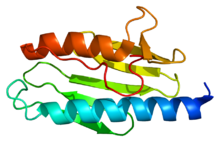User:Mr. Ibrahem/Friedreich's ataxia
Template:Good article is only for Wikipedia:Good articles.
| Friedreich's ataxia | |
|---|---|
| Other names | Spinocerebellar ataxia, FRDA, FA |
 | |
| Frataxin | |
| Specialty | Neurology |
| Symptoms | Difficulty walking, loss of sensation, impaired speech that worsens over time[1] |
| Complications | Cardiomyopathy, vision loss, hearing loss, scoliosis, diabetes[1] |
| Usual onset | 5–15 years[2] |
| Duration | Long-term[1] |
| Causes | Genetic (autosomal-recessive)[2] |
| Diagnostic method | Medical history, examination, genetic testing[2] |
| Differential diagnosis | Spinocerebellar ataxia, Charcot Marie Tooth disease, Ataxia telangiectasia[3] |
| Treatment | Supportive care[3] |
| Prognosis | Life expectancy ~ 37 years[4] |
| Frequency | 1 in 50,000 (United States)[2] |
Friedreich's ataxia (FRDA or FA) is a genetic disease that results in difficulty walking, loss of sensation, and impaired speech that worsens over time.[1] Mental functions are otherwise normal.[2] Symptoms generally start between 5 and 15 years of age.[2] As the disease progresses, many develop hypertrophic cardiomyopathy and lose their sight and hearing.[1] Other complications may include scoliosis and diabetes.[1]
The condition is inherited from a persons parents in an autosomal-recessive manner.[1] It occurs due to a mutations in the FXN gene on chromosome 9, which results in decreased production of a protein called frataxin.[1] This results in damage to highly active cells including neurons, heart cells, and pancreatic beta cells.[1] Diagnosis is often based on symptoms and confirmed by genetic testing.[2]
There is no specific treatment, though symptoms and complications may be managed.[2] This may include physiotherapy, mobility aids such as wheelchairs, and hearing aids.[1][2] FRDA shortens life expectancy to around 37 years,[4] though some live into their 60s or older.[2]
FRDA affects one in 50,000 people in the United States and is the most common inherited ataxia.[2] Rates are highest in Europe, the Middle East, South Asia, and North Africa.[3] The condition is named after German physician Nikolaus Friedreich, who first described it in 1863.[1] Research is ongoing with respect to a number of potential treatments.[4]
References[edit]
- ^ a b c d e f g h i j k Williams, CT; De Jesus, O (January 2021). "Friedreich Ataxia". PMID 33085346.
{{cite journal}}: Cite journal requires|journal=(help) - ^ a b c d e f g h i j k "Friedreich Ataxia Fact Sheet". www.ninds.nih.gov. National Institute of Neurological Disorders and Stroke. Retrieved 11 May 2021.
- ^ a b c "Friedreich's Ataxia". NORD (National Organization for Rare Disorders). Retrieved 11 May 2021.
- ^ a b c Cook, A; Giunti, P (1 December 2017). "Friedreich's ataxia: clinical features, pathogenesis and management". British medical bulletin. 124 (1): 19–30. doi:10.1093/bmb/ldx034. PMID 29053830.
